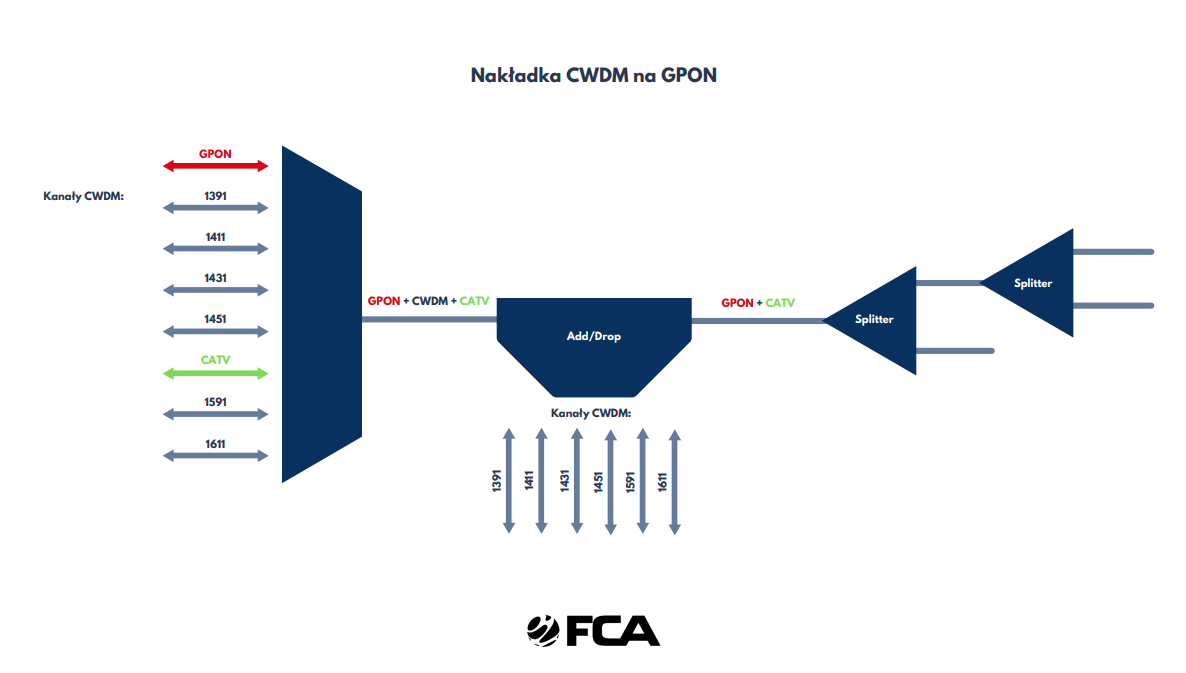On how to increase fiber capabilities with CWDM based on GPON technology
8 March 2024
#FCAteam

More and more often you can find a fiber optic network based on GPON technology. This is not surprising – it has great potential due to the guarantee of a fast and secure Internet connection it provides.
But what does GPON actually mean?
Gigabit Passive Optical Network (GPON for short) is the answer to the need for efficient technology that customers now expect. It enables efficient operation not only of the Internet but also of television or telephony.
It is most commonly used in networks built using FTTH technology. It provides a throughput of 2488 Mbps download and 1244 Mbps upload, analyzing transmission from the side of ONT subscriber units to OLT hub. Transmission is carried out through a single optical fiber by using WMD technology. In addition, all ONT terminals are dynamically assigned a time slot in which they can transmit, so TDMA (i.e. multiplexing of time-sharing access to the medium) technique is also used here.
Such transmission is carried out on a single optical fiber using two wavelengths – 1490nm and 1310nm, respectively.
Given the current digital transformation and the enormous activity of network users, it appears that frequently the access network in one place (e.g., a townhouse) is overloaded.
Individual customers using Internet, TV, or telephone resources at low intensity may not feel the difference in data transmission.
The situation is different for business customers. Why? The use of services within the same access network is more intensive with them. Operators, therefore, need to increase bandwidth capacity and perform traffic separation.
With the following case study, you will learn how a telecom operator separated residential and business customer traffic on a single fiber with a GPON connection.
Need: Isolate customer traffic in the access network
This was the challenge our client was facing. His large customers were demanding improvements in the quality of service, and there was a risk of breaking contracts. The operator realized that the access network he offers on a given fiber, despite the services already present on it based on GPON technology, is insufficient.
The first idea that emerged was to create a separate network for business customers. Unfortunately, it turned out that all the remaining fibers that could be considered for the creation of a new network are already occupied. All that was left was the current optical cable, with a working GPON in the G.984.2 standard. So, the question arose – how to increase its capacity?
Solution: CWDM deployment
The solution to this problem is to use an additional CWDM “overlay” that will enable dedicated wavelengths to be prepared and made available to the customer.
Combining CWDM with GPON results in a significant increase in available bandwidth, while retaining the ability to create a dedicated channel for CATV transmission in the 1550nm band.
As a whole, this ensures optimal utilization of the available fiber, minimization of operating costs and, consequently, customer satisfaction, able to again enjoy reliable data transmission regardless of the instantaneous number of active network subscribers, bandwidth requirements and intensity of their service use.
So what was the purpose of deploying CWDM on fiber with GPON?
- Creation of dedicated wavelengths for the business customer
- Separation of residential and business customers
- Improving fiber utilization efficiency
- Increasing network capacity using fiber occupied by GPON while maintaining concurrent CATV services.
Actions: what steps have we taken?
Implementation of the new technology at the client required taking appropriate measures:
- Gathering data on the Client’s infrastructure to prepare a technical offer accordingly.
- Preparing several variants of the offer for the Client to visualize the cost of a system that meets his current and future needs.
- Creating a set of good practices and guidelines to facilitate the implementation and maintenance of the system.
- Technical support for the customer during the cooperation – after-sales service.
- Verification of the correct operation of the system.
The effects? Satisfying!
- 3 additional 1/10G transmissions
- 7 days to implement the CWDM solution without the need for additional staff training
- PLN 16,000 savings on network modification compared to building 3 km of new cable in ducts and time savings (construction takes much longer than running CWDM on existing fiber)
And what did the network look like using the CWDM overlay? Take a look for yourself!


Would you like to apply CWDM to your network?
Contact us!
